Most people who train their upper body want to increase both the strength and size of their chest, which is a good thing because there is a lot of overlap between the two. Both use resistance training to load the muscles through a relatively large range of motion, both use a variety of rep ranges, and both employ a similar proximity to failure in order to generate adaptations in the muscle, nervous system, bony skeleton, and more. Thus, it’s no surprise that good strength training programs tend to produce an increase in muscle size and, similarly, good hypertrophy programs increase strength in the lifts trained given proper nutrition, sleep, and so on.
That said, prioritizing muscle hypertrophy requires a slightly different approach to maximize results.
Our favorite exercises to prioritize muscle hypertrophy in the chest are:
- Barbell bench press and dumbbell fly for the whole chest.
- Incline dumbbell press and cable crossover for the upper chest.
- Cable fly and dumbbell pullover for the middle chest.
- 15-degree decline dumbbell bench press and angled bar dips for the lower chest.
First Things First: What is Hypertrophy?
Muscular hypertrophy refers to the increase in muscle mass, which occurs from lifting weights. Weightlifting or resistance training allows muscle fibers to increase in size, as research suggests that the number of muscle fibers we have are relatively fixed by our first year of life. [1-4]. Muscle hypertrophy is caused by a phenomenon called muscle protein synthesis, in which our bodies produce new muscle protein. Muscle protein synthesis is triggered both by consuming protein and resistance training. In essence, this is what allows people to bulk up. We’ll talk some more about how hypertrophy works after we cover the best chest exercises.
Best Exercises for Hypertrophy
Contrary to the popular belief that hypertrophy is triggered mainly through isolation exercises, this is not the case, as pretty much any chest exercise will lead to an increase in muscle size. As a matter of fact, hypertrophy is best achieved when the chest muscles are trained using a variety of exercises, especially ones that target the muscles at different angles and use a different repetition scheme to drive growth. So, we’ve picked out a couple of exercises that seem to target each different area of the chest.
Whole Chest
1. Barbell Bench Press
- Movement Category: Primary
- Programming: 3 to 4 sets of 4 to 6 repetitions
- Weight: Use a weight that leaves you 2 to 3 reps short of failure, e.g. RPE 7 to 8.
The barbell bench press is a compound (multi-joint) exercise that is popular among many gym-goers, as it can produce effective results in trainees of any fitness level. It’s one of the go-to exercises for pressing strength and growing the pressing muscles in size. It’s also a competitive lift performed by powerlifters, making it a favorite among lifters, beginners to advanced. Barbell bench presses recruit the pectoralis major, anterior deltoid and triceps brachii as the primary movers.
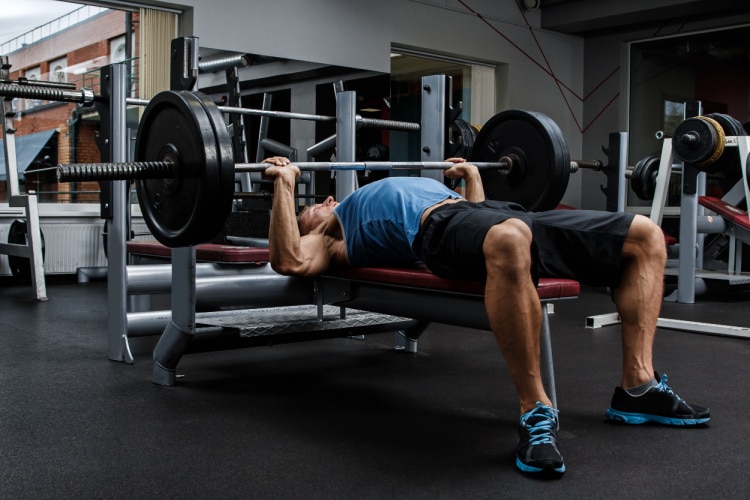
To do barbell bench presses:
- Lay down on the bench with your head slightly in front of the barbell if viewed from the side. This helps ensure there’s enough room for the bar to move up and down without hitting the rack.
- Grab the bar with an overhand grip, using a grip width that’s about 1- to 2-hand widths’ outside your shoulders. (See below)
- Before lifting the bar out of the rack, fix your eyes on a point on the ceiling somewhere just in front (towards your feet) of the bar and pull your shoulder blades back into the bench.
- Lift the bar out of the rack and let it settle just over the shoulder joint.
- Take a big breath and hold it.
- Bring the bar down to touch your sternum, approximately 2 to 3” forward of where the bar started over the shoulder joint. In this position, the elbows and humerus should be angled at ~ 30 to 45 degrees relative to the torso.
- Press the barbell up and back so that it ends up directly over the shoulder joint.
Grip Tip:
Grip width is mostly personal preference, as some prefer closer or wider hand placement. In general, the wider the grip width, the more the elbows will be “flared” directly out to the sides, and the higher on the chest the bar will touch. Similarly, the closer the grip is, the lower the bar will touch on the chest, and the more the elbows will be “tucked” into the sides. Check out this video for more in-depth instructions.
2. Dumbbell Flyes
- Movement Category: Tertiary
- Programming: 2 to 4 sets of 10 to 15 reps
- Weight: Use a load that gets you 1 to 2 reps short of failure, e.g. RPE 8 to 9.
Dumbbell flyes are a great addition to the barbell bench press. It offers a larger range of motion for the pectoralis major and requires less active contribution from the triceps brachii. The barbell bench press and dumbbell flyes aren’t really interchangeable. Instead, they’re a compliment to each other when prioritizing hypertrophy.
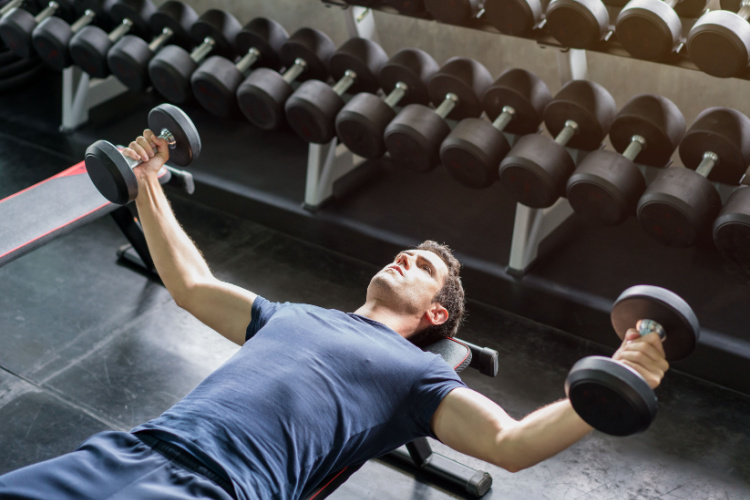
To do a dumbbell fly:
- Pick up the dumbbells and lie down flat on the bench. Bend your elbows at 90 degrees, palms holding the dumbbells facing in.
- Press the dumbbells up to maximum height until your arms are locked out. Bring the dumbbells together in the middle.This would be your starting position.
- Slowly lower your arms laterally on each side until you feel a stretch in your pectoral muscles. Avoid lowering your arms below chest height, as this could cause an injury.
- Keep your arms bent slightly at the elbows and to the sides for a second. Then, slowly lift them back to the starting position.
- Squeeze your pecs when you reach the top and hold for a second.
Upper Chest
1. Incline Dumbbell Press
- Movement Category: Secondary
- Programming: 3 to 4 sets of 8-12 repetitions.
- Weight: Use a weight that leaves you 2 to 3 reps short of failure, e.g. RPE 7 to 8.
The incline dumbbell press helps develop the tricep muscles, as well as synergists like the anterior deltoids of the shoulder. Many claim that incline presses target the upper pecs and shoulders more effectively than flat bench presses, but there isn’t enough evidence to support this claim. Some studies have found differences in muscle excitation while training with different bench angles, but this isn’t predictive of actual outcomes, so we can’t say that one inclination is particularly better for building strength or hypertrophy. [19-22]
That being said, the incline bench press is still a great exercise that can either be incorporated into your chest workout or full-body routine. The angle of the bench would largely depend on personal preferences. For example, if you’re training for strength, a lower incline like 15 degrees will likely transfer better to a flat bench press. Training with a higher incline, such as 45 or 70 degrees, would transfer better to an overhead press.
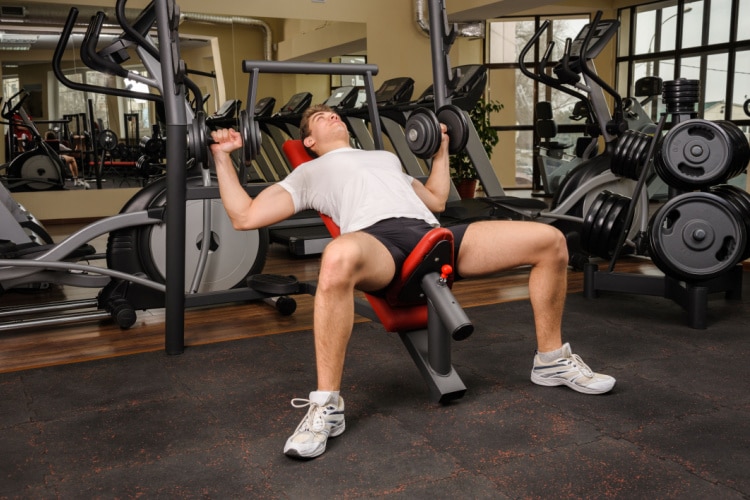
To do an incline dumbbell press:
- Set the bench inclination to anything between 15 and 30 degrees.
- Pick up the dumbbells and lie down on the bench. Your palms should be facing inwards while holding the dumbbells in a neutral grip.
- Inhale and on the exhale, press the dumbbells up to lockout at the top. This is your starting position.
- Lower your arms back down to chest level, bending the elbows at 90 degrees, so that the upper arm is parallel to the floor. Do the movement with as much control as possible.
- Do three to four sets of 8 to 12 reps.
2. High-to-Low Cable Crossover
- Movement Category: Tertiary
- Programming: 2 to 4 sets of 10 to 15 reps
- Weight: Use a load that gets you 1 to 2 reps short of failure, e.g. RPE 8 to 9.
With the wide range of motion and the constant resistance it provides, the high-to-low cable crossover is great for isolation of the upper and inner chest. A whole lot of control is required to execute this movement accurately, making it a wonderful exercise to enhance your attentional focus, e.g. the mind-muscle connection, as well.
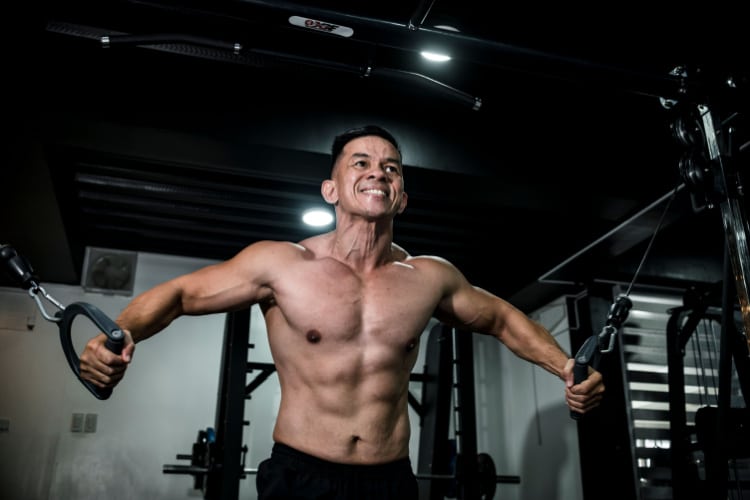
To do a cable crossover:
- Adjust the pulleys to their highest position and connect the single grip handles.
- Add your preferred weight on the stacks.
- Grab the handles and hold them with your palms facing downwards.
- Take a big step forward with one leg.
- Pull the cables to the lowest position. Your hands should slightly cross over each other, at waist height. This is your starting position.
- Slowly open up your arms to the T position.
- Pull the cables back to the starting position slowly and with control.
Middle Chest
1. Cable Fly
- Movement Category: Secondary
- Programming: 3 to 4 sets of 8-12 repetitions.
- Weight: Use a weight that leaves you 1 to 2 reps short of failure, e.g. RPE 8 to 9.
While it is possible to do cable flies at different angles to target different muscle groups, today we share the exact technique that may prioritize the middle and inner aspect of your pectoralis major. The great thing about cable flies is that, unlike exercises that involve a bench, a standing cable fly can be more demanding for the muscle groups that are engaged, meaning that you could efficiently train for hypertrophy with much lower loads. [5]
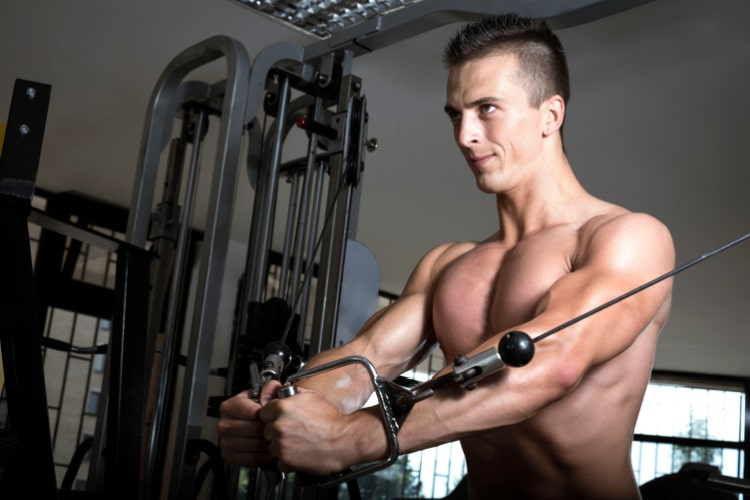
To do a cable fly for chest hypertrophy:
- Adjust the cable pulleys to shoulder height.
- Add your preferred weight on the rack.
- Hold the pulleys with your arms extended out to the sides in a T. Your arms should be at chest height and your shoulders locked back and down
- Take a big step forward with one leg and keep your chest upright. This is your starting position.
- Take a breath and on the exhale, connect your arms in front of you while keeping them straight and at chest level.
- Keep in mind that your arms should form a 90-degree angle with your body at all times.
- Slowly draw your arms back to the starting position.
- Repeat for as long as you can.
Alternatively, you could try to target your upper and lower chest with cable flies. To target the upper chest, you’d have to adjust the pulleys to waist height and your arms would have to create an angle wider than 90 degrees with your body when locked out. To train your lower chest, you’d have to set the pulleys to overhead height and pull the handles down to create an angle narrower than 90 degrees with your body.
2. Dumbbell Pullover
- Movement Category: Tertiary
- Programming: 2 to 4 sets of 10 to 15 reps
- Weight: Use a load that gets you 1 to 2 reps short of failure, e.g. RPE 8 to 9.
With the dumbbell pullover, we venture a bit more into the lower chest area and serratus anterior, while still making use of all our middle chest muscles. This makes the exercise the perfect precursor to our lower chest exercises. Dumbbell pullovers also work the latissimus dorsi, but likely not as much as they work the pectoralis major. [6]
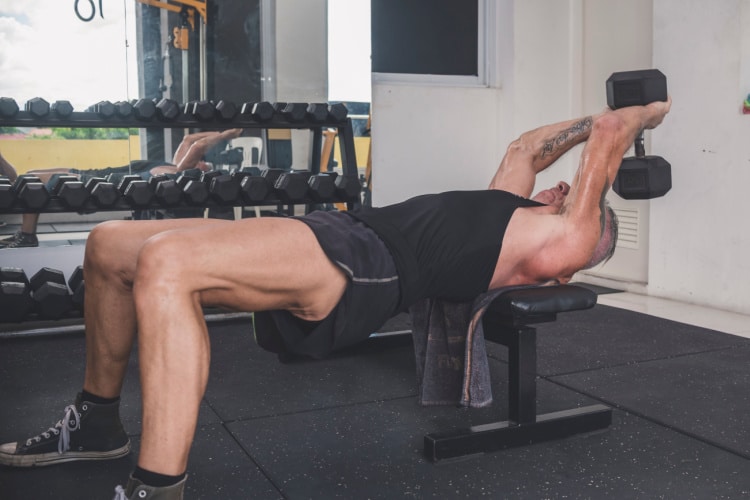
To do a dumbbell pullover for chest hypertrophy:
- Lie on the bench with a slight arch in your lower back.
- Keep your feet flat on the ground to maximize stability.
- Keep your knees bent at 90 degrees.
- Hold the dumbbell up over the center of your mid-chest area with both of your hands. This is your starting position.
- Maintain a slight bend at your elbows and lower the dumbbell over and beyond your head with maximum control.
- Aim to get the dumbbell as close to the ground as possible. Feel the stretch in your pecs and lats.
- Return to the starting position.
- Do four sets of 12 repetitions.
Lower Chest
1. 15-Degree Decline Dumbbell Press
- Movement Category: Secondary
- Programming: 3 to 4 sets of 6 to 10 repetitions.
- Weight: Use a weight that leaves you 2 to 3 reps short of failure, e.g. RPE 7 to 8.
The decline bench press is a variation of the bench press where the bench being used is angled downwards relative to the floor about 15 to 30 degrees. Whereas an incline dumbbell bench seems to generate more muscle excitation in the upper portion of the pectoralis major, the decline dumbbell bench does the opposite – showing increased excitation of the lower sternocostal and/or abdominal portions. [7]
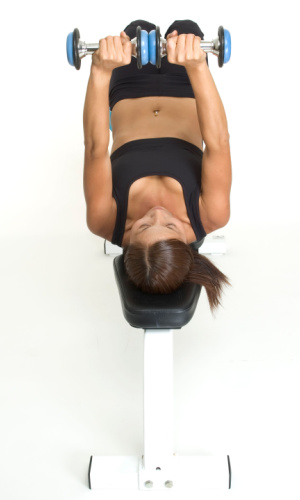
To do a decline dumbbell press for chest hypertrophy:
- Set the bench to a 15-degree decline.
- Pick up the dumbbells and lie down on the bench. Your palms should be facing inwards and holding the dumbbells in a neutral grip. Your elbows should be bent at 90 degrees. This is your starting position.
- Inhale and on the exhale, press the dumbbells up until your arms are locked out at the top.
- Lower your arms back down to the starting position slowly, with as much control as possible.
2. Parallel Bar Dips
- Movement Category: Secondary
- Programming: 2-3 sets until failure
- Weight: Body weight; additional weight optional.
Bar dips primarily target the pectoralis major and minor, anterior deltoid, and triceps. Similar to bench presses, bar dips can be performed at different angles to drive different strength and hypertrophy results. Some claim that doing dips with a more vertical torso targets the shoulders and triceps more, while doing dips with a forward-leaning torso targets the chest more. These claims are mostly speculative, so we recommend trying both and seeing what you prefer and respond best to.
This exercise can be performed using only your body weight, or with additional weights in the form of a dip belt with weights, chains, or even a weighted vest, depending on your fitness level and the rep scheme being used. They can also be done with assistance from a band or Gravitron machine.
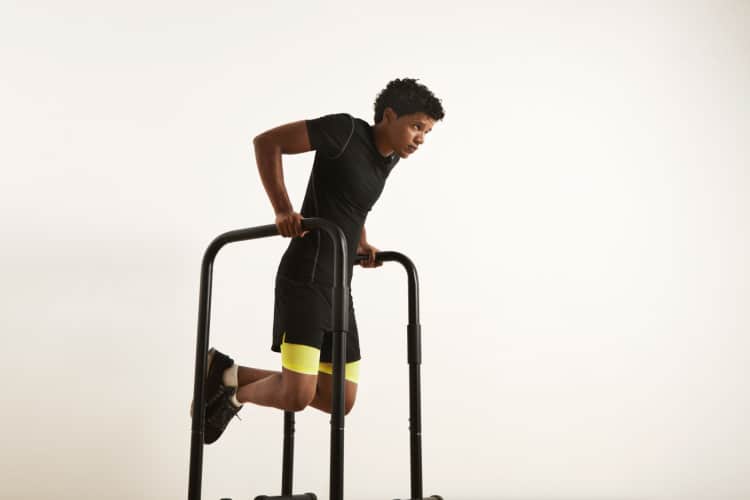
To do a parallel bar dip for chest hypertrophy:
- Hold onto the bars and pull yourself up until your arms are locked out.
- Lean forward and angle your chest slightly towards the ground.
- Tuck your legs under and cross them at your ankles.
- Slowly, lower yourself as much as possible (for most trainees, this will be around the time their elbows reach 90-degree angles) and hold for a second at the lowest position.
- Slowly raise yourself up until your arms are locked out again.
How Hypertrophy Works
All forms of resistance training have the potential to drive muscle growth in the chest. However, each trainee responds differently to exercise, meaning that the training should be personalized according to their fitness goals.
To fully understand what hypertrophy is and how it works, we’d have the backtrack to the very basics— starting with the definition of muscle hypertrophy. Muscle hypertrophy is what we call an increase in total muscle mass, whereas a decrease in total muscle mass is referred to as atrophy. [8]
An increase in muscle fiber size occurs when muscle protein synthesis outpaces muscle protein breakdown for sustained periods of time. There is a common misconception among the fitness community that the muscle must be damaged for these phenomena to take place, however, hypertrophy actually lags until muscle protein synthesis exceeds muscle protein breakdown by a large margin. This means that if the training dose is too high, hypertrophy might be slow, or may not happen at all.
The changes in muscle fiber size happen due to the muscle trying to adapt to the demands placed upon it through the altering of protein synthesis and breakdown signals. Resistance training requires muscles to produce force in a way that generates metabolic stress. This, in turn, triggers muscle protein synthesis. Even though the mechanisms for increasing muscle mass are the same across the board for all individuals, everyone responds differently to hypertrophy training. For example, a study has shown that changes in muscle size varied between -11% to +30% in 287 adults who followed the same program over a period of 6 months. While variables such as sex and age didn’t really influence the subjects’ hypertrophic response, they all had a unique hypertrophic response to the program. [9] Nonetheless, the variables that drive hypertrophy exhibit similarities across the board.
Tips on How to Maximize Chest Hypertrophy
To fully understand how to grow chest muscles, we’d first have to examine the muscular structure of the chest. Our chest muscles are also referred to as the pectoral muscle group and could be divided into two main muscles: the pectoralis major and the pectoralis minor.
When we train to achieve hypertrophy, we focus mainly on the pectoralis major. The pectoralis major is what is usually referred to by fitness enthusiasts as “pecs” and is divided into two heads :
- the clavicular head, known as the upper chest.
- the sternocostal head, known as the middle and lower chest.
- Note: some refer to an abdominal portion of the pectoralis major as the lower part, though this is considered to be part of the sternocostal head.
Each of these parts needs to be trained for best results. For most, hypertrophy is best achieved when all the muscles are targeted individually, and while compound lifts will build strength and size across both heads, most will require a few isolation exercises to prioritize hypertrophy. After all, you can only train a muscle group for maximum growth by isolating it and loading it with resistance.
So — here are our tips on how to maximize muscle growth in your chest.
Increase Your Strength
As there are a lot of overlaps between the strength and hypertrophy outcomes of a resistance training program, individuals will enjoy some degree of development in either area, even if their program is only focused on one. However, strength is measured in a specific context . For example, both bench presses and push ups can be used to measure strength, but in different contexts, meaning that a bench press test would not be appropriate to measure the strength of someone who’s only trained with push-ups. Either the bench press or exercises that target the muscle through similar mechanisms such as the range of motion, movement velocity, joint angles and contraction type would be the right way to go. Nonetheless, you probably will see some progress in strength, regardless of whether your training is focused on strength or hypertrophy.
Go For Higher Volume
Muscular hypertrophy has been shown to have a direct correlation with training volume, so we could say that the higher the training volume, the greater the hypertrophy. [10,11] However, the key here is to work with a volume that you can tolerate.
One way to increase volume without raising stress to intolerable levels would be to do isolation exercises, or more specifically exercises that only make use of a single joint. This allows the trainee to target a specific muscle group directly compared to doing compound lifts that put stress on multiple muscles at once. [12,13] Isolation exercises also make use of lighter loads and less muscle mass than compound lifts, which could allow trainees to take on any repetition scheme without acquiring too much fatigue.
On the other hand, isolation exercises that work one part of a muscle are easier to do. Isolation exercises can be done with dumbbells, barbells, or a cable machine. These factors lower the risk of injury and allow trainees to work a certain muscle group with more precision.
How to Program for Chest Hypertrophy
Proper programming for chest hypertrophy is based on four important factors; volume, intensity, frequency, and structure:
- Volume refers to the total amount of reps performed, e.g., the product of sets and reps.
- Intensity refers to the weight used for an exercise in either absolute or relative terms, often as a percentage of 1-Repetition Maximum (1RM).
- Frequency refers to how many times you exercise a certain muscle group in a given time period.
- Structure or split refers to the way the training program organizes exercises on training days. Some examples would be total body, lower body split, or muscle group split routines.
Volume
Resistance training volume refers to the total number of repetitions performed in a single workout. Training volume is an extremely important factor to consider when aiming for hypertrophy, as muscular hypertrophy is known to have a dose-dependent relationship with training volume. For example, if the training stress is too high, an individual might incur too much muscle protein breakdown, which may lead to muscular atrophy rather than hypertrophy. So, in order to ensure maximum grains, the training should be dosed appropriately.
Intensity
The load used in a workout, whether absolute or relative, is referred to as intensity. In sports literature, it is commonly expressed as a percentage of 1-Repetition Maximum (1RM), for example, 75% 1RM for 5 repetitions. According to available scientific data, higher intensity—that is, more than 60 to 70% of one’s 1RM—tends to be more effective than lower intensity when it comes to strength gains. [14] However, even larger loads (> 90% 1RM) should be employed for a portion of the training to achieve maximal strength performance. [15] If the sets are performed close to failure, the intensity range for muscle size—roughly 30% to 90% 1RM—is substantially wider and still yields comparable gains. [16]
Frequency
Frequency refers to how often a person trains a particular muscle or muscle group in a given time frame, which is usually assessed per week. For example, a person who does one chest exercise per week has a training frequency of one, while a person who does two chest exercises per week has a training frequency of two, and so on. In most cases, as the frequency increases for a particular exercise of a muscle group, we can observe an increase in training volume as well.
Due to the direct relationship between muscle hypertrophy and training volume, training frequencies must be crafted and adapted in such a way that it doesn’t lead to an decrease in training volume. However, if you manage to alter the frequency of your workout while keeping your suggested training volume constant, you should still be able to achieve the results you normally would with no changes to your training frequency. A recent meta-analysis reviewing 22 studies on exercise frequency was able to conclude that when the exercise volume is equated between programs, the intensity of the programs doesn’t significantly change the results of a program. [17] So, we could say that unless it impacts the training volume, frequency doesn’t really matter and can be programmed according to the individual needs and expectations of the trainee.
But just because it doesn’t make much of a difference, doesn’t mean that there would be no benefits to considering training frequency. For example, doing a higher number of sets in a single weekly session (low frequency) would likely produce more fatigue than spreading the same number of sets over a few days (high frequency). As we accumulate fatigue, it becomes harder to improve skills and movement efficiency, which are crucial to strength performance, so there may actually be a benefit to programming your workout intensity. Plus, it may also provide advantages in terms of time efficiency, since spreading out a workout volume over a few days would entail not spending hours at the gym for a single chest day.
Structure
A training split can be organized in many different ways, such as full body splits, body part splits, or movement pattern splits. We can’t say that there is a single best type of training split, and the one you choose should largely depend on your personal goals and preferences. However, having a weekly program is definitely a good idea.
A “chest day” is a good example of a body-part split, as it pairs up synergistic and agonistic muscles. For a body-part split, the following recommendations could be made to most trainees:
- Train the larger muscle groups first.
- Start your workout with compound lifts and then move your way over to isolation exercises.
- The main difference in recommendations would be on volume, as more experienced lifters will need to do more repetitions to drive hypertrophy and strength.
What to Avoid While Training for Chest Hypertrophy
There are a few mistakes that lifters make while hypertrophy training that could set back their gains or even worse, result in injury.
For starters, some lifters believe that bench press is the best way to increase their chest size. This is unlikely to be true for most folks, as isolation exercises are very effective at generating in the chest as well. [18] Using a combination of both compound and isolation exercises, along with including variety in training in general, are things we recommend to every lifter.
Another common mistake is adding too much volume or intensity too quickly, which can outstrip your ability to recover and adapt to training. This could result in too much fatigue being generated from the training, thereby limiting muscle growth as the individual doesn’t have any resources left over to generate more muscle tissue because all of it is used to keep up with training. Worse yet, increasing training stress from too much volume or intensity could lead to overuse injury.
It’s also important to note that people will respond differently to the same training. Some will thrive and grow like a weed on the most basic of programs, whereas others will have to be more calculated and intentional with their program design and progressive loading. While many concepts in exercise programming are good rules of thumb, tailoring the program to the individual is necessary to achieve the best results.
Train With Us
One thing to note about hypertrophy training is that growing muscle is a long-term process where the program is definitely not one-size-fits-all. People respond differently to training and, as you’d expect, tend to need different approaches so that the lifter gets the most out of their workouts. We’d love to help you get the perfect hypertrophy program to maximize your gains and prevent setbacks.
At Barbell Medicine, we offer evidence-backed programs based on the latest developments in sports science. If you’d like to get a strong start to your hypertrophy training, consider checking out our hypertrophy-focused training templates: Hypertrophy I, Hypertrophy II, Bodybuilding I, and Bodybuilding II. You can also check our article on the best programs for hypertrophy for more recommendations.
If you’re not too keen on following pre-made templates and would like a more personalized approach, we also create personalized programs for our clients based on their current fitness level and goals. Don’t hesitate to reach out to our coaches to receive a tailor-made training program just for you.
Recap
The chest covers quite a large part of our bodies, and to achieve maximum hypertrophy – or increase in muscle mass – all areas of the chest must be targeted in isolation. So, to recap the best chest exercises for hypertrophy are:
- Barbell bench presses and dumbbell flies to target the whole chest.
- Incline dumbbell presses and cable crossovers to target the upper chest.
- Cable flyes and dumbbell pullovers to target the middle chest.
- 15-degree decline dumbbell press and angled bar dips for the lower chest.
Additionally, remember to include the maximum amount of repetitions you can in a single exercise, lift up to 80% of your 1RM, and get in six to ten chest exercises per week spread across at least two workout sessions.
More Chest Training Articles:
Checkout these chest training articles to help further develop your chest muscles:
- Best Chest Exercises
- Best Chest Workout Without Equipment
- Best Cable Chest Exercises
- Best Lower Chest Exercises
- How Many Chest Exercises Per Workout?
- Best Chest and Triceps Workout
References:
- MacDougall, J D et al. “Muscle fiber number in biceps brachii in bodybuilders and control subjects.” Journal of applied physiology: respiratory, environmental and exercise physiology vol. 57,5 (1984): 1399-403.
doi:10.1152/jappl.1984.57.5.1399
- 2 Boonyarom, O, and K Inui. “Atrophy and hypertrophy of skeletal muscles: structural and functional aspects.” Acta physiologica (Oxford, England) vol. 188,2 (2006): 77-89. doi:10.1111/j.1748-1716.2006.01613.x
- 3Jorgenson, Kent W et al. “Identifying the Structural Adaptations that Drive the Mechanical Load-Induced Growth of Skeletal Muscle: A Scoping Review.” Cells vol. 9,7 1658. 9 Jul. 2020, doi:10.3390/cells9071658
- 4Antonio, J, and W J Gonyea. “Skeletal muscle fiber hyperplasia.” Medicine and science in sports and exercise vol. 25,12 (1993): 1333-45.
- Schoenfeld, Brad J. “The mechanisms of muscle hypertrophy and their application to resistance training.” Journal of strength and conditioning research vol. 24,10 (2010): 2857-72. doi:10.1519/JSC.0b013e3181e840f3
- Ahtiainen, Juha P et al. “Heterogeneity in resistance training-induced muscle strength and mass responses in men and women of different ages.” Age (Dordrecht, Netherlands) vol. 38,1 (2016): 10. doi:10.1007/s11357-015-9870-1
DOI: 10.1519/JSC.0b013e3181e840f3
- Glass, Stephen C.; Armstrong, Ty. Electromyographical Activity of the Pectoralis Muscle During Incline and Decline Bench Presses. Journal of Strength and Conditioning Research 11(3):p 163-167, August 1997.
- Boonyarom, O, and K Inui. “Atrophy and hypertrophy of skeletal muscles: structural and functional aspects.” Acta physiologica (Oxford, England) vol. 188,2 (2006): 77-89. doi:10.1111/j.1748-1716.2006.01613.x
- Ahtiainen, Juha P et al. “Heterogeneity in resistance training-induced muscle strength and mass responses in men and women of different ages.” Age (Dordrecht, Netherlands) vol. 38,1 (2016): 10. doi:10.1007/s11357-015-9870-1
- Krzysztofik, M., Wilk, M., Wojdała, G., & Gołaś, A. (2019). Maximizing Muscle Hypertrophy: A Systematic Review of Advanced Resistance Training Techniques and Methods. International journal of environmental research and public health, 16(24), 4897. https://doi.org/10.3390/ijerph16244897
- Schoenfeld, Brad J. The Mechanisms of Muscle Hypertrophy and Their Application to Resistance Training. Journal of Strength and Conditioning Research 24(10):p 2857-2872, October 2010. |
DOI: 10.1519/JSC.0b013e3181e840f3
- Schoenfeld, B. J., Ogborn, D., & Krieger, J. W. (2016). Effects of Resistance Training Frequency on Measures of Muscle Hypertrophy: A Systematic Review and Meta-Analysis. Sports medicine (Auckland, N.Z.), 46(11), 1689–1697. https://doi.org/10.1007/s40279-016-0543-8
- Gentil, P., Soares, S., & Bottaro, M. (2015). Single vs. Multi-Joint Resistance Exercises: Effects on Muscle Strength and Hypertrophy. Asian journal of sports medicine, 6(2), e24057. https://doi.org/10.5812/asjsm.24057
- Schoenfeld, Brad J et al. “Strength and Hypertrophy Adaptations Between Low- vs. High-Load Resistance Training: A Systematic Review and Meta-analysis.” Journal of strength and conditioning research vol. 31,12 (2017): 3508-3523. doi:10.1519/JSC.0000000000002200
- 15. Androulakis-Korakakis, Patroklos et al. “Reduced Volume ‘Daily Max’ Training Compared to Higher Volume Periodized Training in Powerlifters Preparing for Competition-A Pilot Study.” Sports (Basel, Switzerland) vol. 6,3 86. 29 Aug. 2018, doi:10.3390/sports6030086
- Schoenfeld, Brad J et al. “Strength and Hypertrophy Adaptations Between Low- vs. High-Load Resistance Training: A Systematic Review and Meta-analysis.” Journal of strength and conditioning research vol. 31,12 (2017): 3508-3523. doi:10.1519/JSC.0000000000002200
- Grgic, J., Schoenfeld, B.J., Davies, T.B. et al. Effect of Resistance Training Frequency on Gains in Muscular Strength: A Systematic Review and Meta-Analysis. Sports Med 48, 1207–1220 (2018). https://doi.org/10.1007/s40279-018-0872-x
- Gentil, P., Soares, S., & Bottaro, M. (2015). Single vs. Multi-Joint Resistance Exercises: Effects on Muscle Strength and Hypertrophy. Asian journal of sports medicine, 6(2), e24057. https://doi.org/10.5812/asjsm.24057
- 1 Saeterbakken, Atle Hole et al. “The Effects of Bench Press Variations in Competitive Athletes on Muscle Activity and Performance.” Journal of human kinetics vol. 57 61-71. 22 Jun. 2017, doi:10.1515/hukin-2017-0047
- 2 Christian, Jamison R et al. “Analysis of the Activation of Upper-Extremity Muscles During Various Chest Press Modalities.” Journal of strength and conditioning research vol. 37,2 (2023): 265-269. doi:10.1519/JSC.0000000000004250
- 3 Vigotsky, Andrew D et al. “Greater electromyographic responses do not imply greater motor unit recruitment and ‘hypertrophic potential’ cannot be inferred.” Journal of strength and conditioning research vol. 31,1 (2017): e1-e4. doi:10.1519/JSC.0000000000001249
- 4 Chaves, Suene F N et al. “Effects of Horizontal and Incline Bench Press on Neuromuscular Adaptations in Untrained Young Men.” International journal of exercise science vol. 13,6 859-872. 1 Aug. 2020